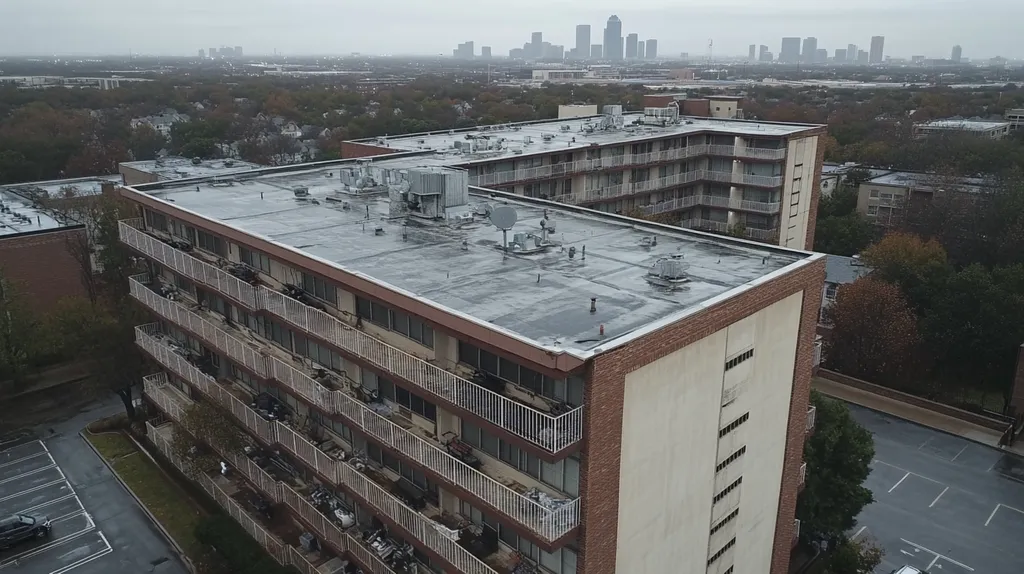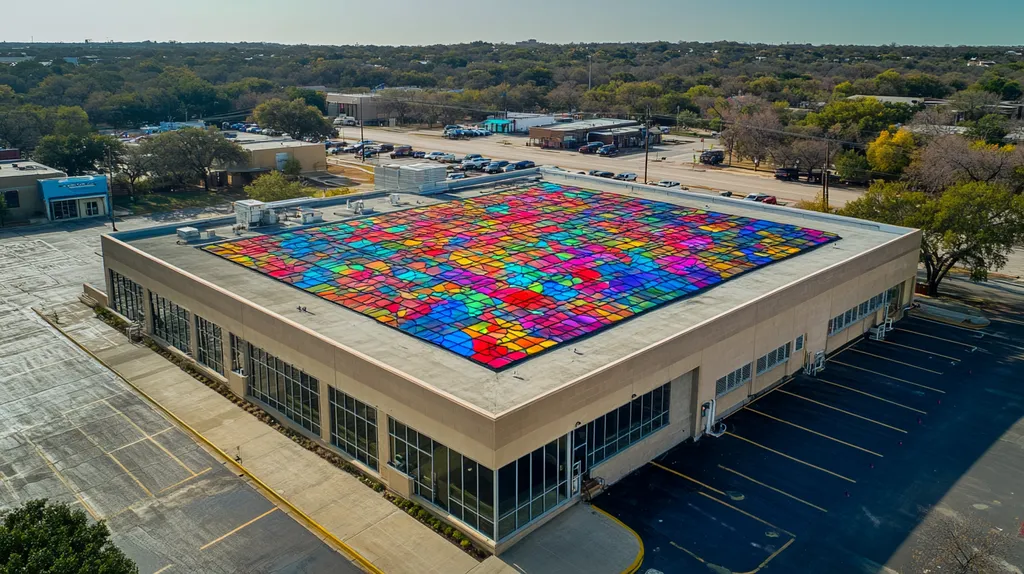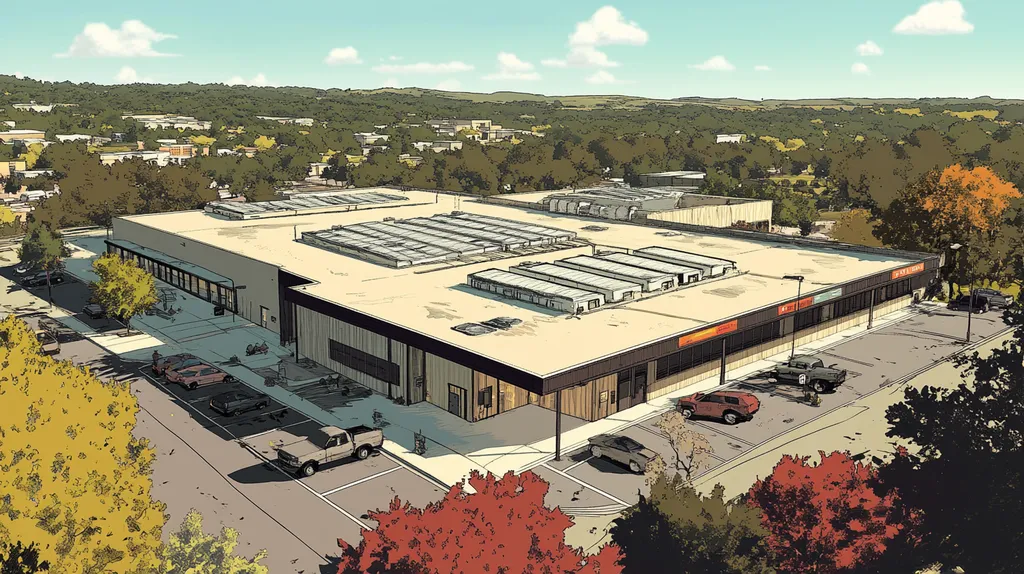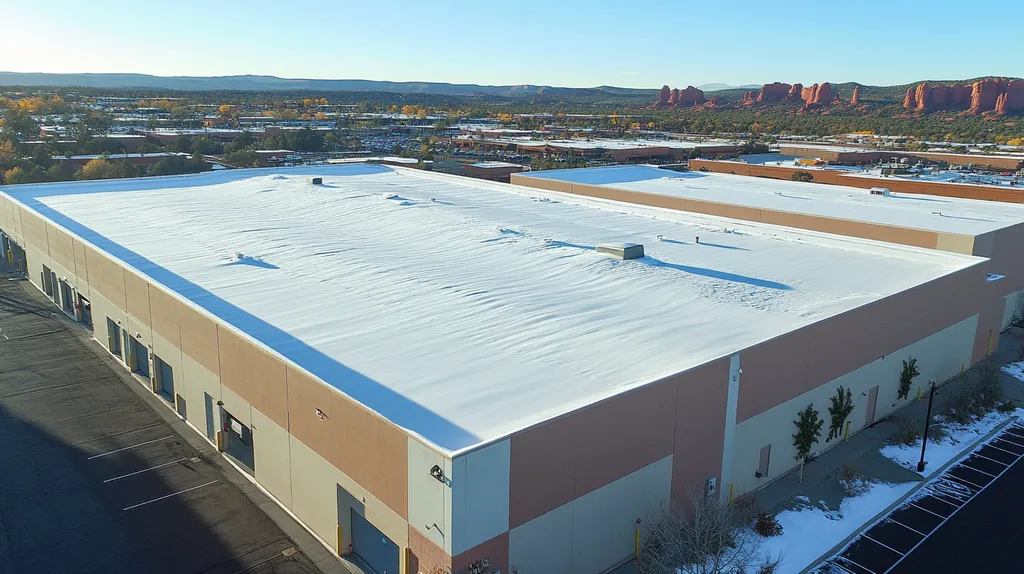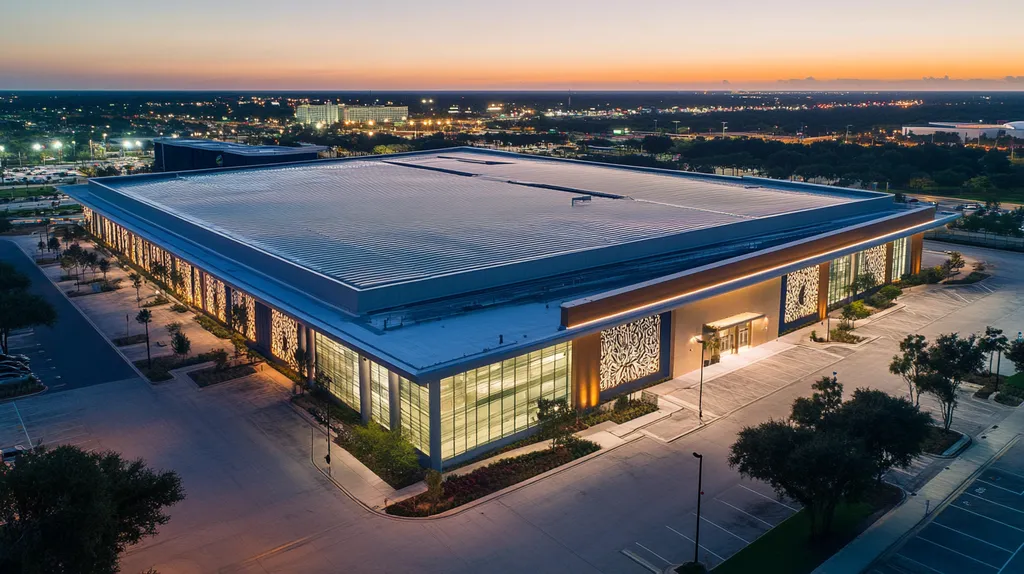Each year, commercial roof replacements generate over 8 million tons of debris in the United States, with up to 85% of materials potentially recyclable yet most ending up in landfills.
This massive waste of reusable resources costs property owners millions in disposal fees while straining already-limited landfill capacity.
Modern recycling technologies and processes now make it possible to reclaim most roofing materials, reducing disposal costs by up to 60% while supporting sustainability goals.
This comprehensive guide examines the fundamentals, methods, and optimization strategies for implementing successful roofing material recycling programs in commercial and industrial facilities.
SECTION 1: FUNDAMENTAL CONCEPTS
The roofing industry faces a critical waste management challenge, with commercial roof replacements generating over 8 million tons of debris annually in the United States. While traditional disposal methods strain landfill capacity and waste valuable resources, innovative recycling approaches offer sustainable alternatives. Understanding the fundamentals of roofing material recycling has become essential for property owners and facility managers seeking to reduce environmental impact while managing costs effectively.
Overview of Roofing Material Recycling in Industrial Applications
Successful roofing material recycling begins with proper waste separation at the job site. Loads must be meticulously segregated, with materials like shingles kept separate from other debris to ensure recyclability.
Clean separation practices significantly reduce contamination risks and minimize the chance of load rejection at recycling facilities. When contractors properly sort materials during removal, they can maximize the value of recyclable components while minimizing disposal costs.
Metal components, including flashing and trim, represent the highest value recyclable materials from commercial roofs. These materials can be sorted by type and sold directly to metal recyclers.
Membrane materials and insulation require specialized handling but can often be processed into raw materials for new manufacturing. For maximum efficiency, contractors should coordinate with recycling facilities before project start to understand material acceptance criteria. (source: 2011 International Roofing Symposium)
Environmental and Economic Benefits of Roof Material Recycling
Recycling roofing materials delivers immediate environmental benefits by diverting thousands of tons of waste from landfills. This reduction in landfill use helps preserve valuable disposal capacity while minimizing groundwater contamination risks.
The economic advantages of recycling extend beyond reduced disposal fees. Properly sorted materials often have significant resale value, creating new revenue streams for building owners and contractors.
Energy savings represent another key benefit, as recycling materials typically requires less energy than processing raw materials. This reduced energy consumption translates to lower carbon emissions and decreased environmental impact.
Building owners who implement comprehensive recycling programs often qualify for environmental certifications and local government incentives. These credentials can enhance property value while demonstrating environmental leadership.
Regulatory Framework and Compliance in U.S. Roofing Recycling
Federal regulations increasingly emphasize construction waste reduction, with many states now requiring recycling plans for large commercial projects. These requirements typically specify minimum recycling percentages and documentation procedures.
Local ordinances often mandate specific handling procedures for different roofing materials. Understanding these requirements helps avoid costly violations and ensures smooth project execution.
Most jurisdictions require detailed tracking of recycled materials through waste management plans. These plans must document the types and quantities of materials recycled, along with their final disposition.
Compliance responsibilities extend beyond the construction phase, with many areas requiring annual reporting of recycling activities. Maintaining proper documentation supports both regulatory compliance and sustainability reporting requirements.
SECTION 2: SYSTEM COMPONENTS
Modern commercial roofing generates over 10 million tons of waste annually, with up to 85% of materials potentially recyclable. Yet most roofing debris still ends up in landfills due to inadequate sorting and processing systems. Understanding the key components of effective roofing recycling programs helps facility managers maximize material recovery while minimizing disposal costs.
Types of Commercial Roofing Materials Suitable for Recycling
Metal components represent the most valuable recyclable materials from commercial roofs. Copper flashing, aluminum trim, and steel fasteners can all be sorted by type and sold to metal recyclers, often generating significant returns.
Single-ply membrane materials like TPO and EPDM can be processed into raw materials for new manufacturing. These materials must be kept clean and separated from other components to maintain recyclability.
Built-up roofing materials, including modified bitumen and asphalt-based products, can be recycled into road construction materials. The asphalt content makes these materials particularly valuable when properly processed.
Insulation materials vary in recyclability based on type and condition. Clean, dry polyisocyanurate (ISO) boards can often be reused directly or processed into new insulation products.
Common Contaminants and Materials Separation Techniques
Successful recycling requires meticulous separation of materials during roof removal. Loads must be carefully segregated with only clean, sorted materials of each type grouped together.
Personnel should inspect materials both during removal and at the recycling facility to ensure proper separation. Contaminated loads face rejection at recycling centers, resulting in costly landfill disposal.
Common contaminants include wood debris, vegetation, and mixed construction waste. These materials must be removed and disposed of separately to maintain the quality of recyclable components.
Proper planning and worker training in separation techniques significantly improve recycling success rates. Each load should be carefully documented to track material types and quantities. (source: 2011 International Roofing Symposium)
Equipment and Technologies for Material Processing
Modern recycling facilities employ specialized equipment to process roofing materials efficiently. Industrial shredders break down large sections into manageable pieces, while sorting systems separate different material types.
Magnetic separators extract metal components automatically, improving processing speed and recovery rates. Advanced optical sorting technology helps identify and separate different types of membrane materials.
Granulation equipment reduces materials to uniform sizes suitable for remanufacturing. These systems can process several tons of material per hour when properly maintained.
Quality control systems, including moisture meters and contamination detectors, ensure processed materials meet manufacturing specifications. Regular equipment maintenance and calibration maximize processing efficiency while maintaining material quality.
SECTION 3: IMPLEMENTATION METHODS
Every year, commercial roof replacements generate millions of tons of recyclable materials that could be diverted from landfills. Yet successful recycling requires precise implementation methods at every stage – from initial tear-off to final processing. With proper protocols, facilities can transform what was once considered waste into valuable resources while significantly reducing disposal costs. Understanding these implementation methods is crucial for property owners looking to maximize both environmental and financial benefits.
Collection and Sorting Protocols for Tear-Off Materials
Most recycling centers can reclaim metals, wood, and plastics from roofing materials to create additional revenue streams. However, this requires implementing strict sorting protocols from the moment tear-off begins.
Loads must be meticulously segregated with targeted materials kept separate from other debris. Any loads contaminated with prohibited items face rejection at recycling facilities, forcing costly landfill disposal at the contractor’s expense.
Successful sorting starts with proper container placement and clear labeling. Using dedicated containers for each material type prevents cross-contamination and streamlines the recycling process.
Training crews in proper identification and handling techniques is essential. Workers must understand which materials can be recycled and how to maintain material separation throughout the removal process.
Documentation systems should track quantities and types of materials collected. This data helps optimize future sorting efforts while providing necessary documentation for sustainability reporting. (source: 2011 International Roofing Symposium)
Transportation and Storage Considerations for Recyclables
Proper transportation planning prevents material damage and contamination during transit. Vehicles must be properly equipped with appropriate containment systems and covering materials.
Loading procedures should maintain material separation established during sorting. Strategic load sequencing prevents materials from mixing during transport.
On-site storage requires dedicated spaces away from other construction activities. Weather protection prevents material degradation that could impact recyclability.
Coordination with recycling facilities optimizes pickup scheduling. Regular communication ensures materials move efficiently from the job site to processing facilities.
Integration of Recycled Materials into New Roofing Products
Modern manufacturing processes can transform recycled roofing materials into high-performance products. These materials often match or exceed the durability of virgin materials while reducing environmental impact.
Quality control systems ensure recycled content meets strict performance standards. Regular testing verifies material properties remain consistent across production runs.
Many manufacturers now offer product lines with significant recycled content. These options give property owners sustainable choices without compromising system performance.
Using recycled materials can reduce project costs while supporting sustainability goals. The growing market for recycled products continues driving innovation in material processing and manufacturing.
SECTION 4: MAINTENANCE REQUIREMENTS
With recycled materials now comprising up to 40% of modern commercial roofing systems, maintaining these sustainable components demands specialized knowledge and protocols. Poor maintenance practices can lead to premature failure, negating both environmental and cost benefits. Understanding the unique characteristics of recycled roofing materials and implementing proper maintenance strategies is essential for protecting your investment while advancing sustainability goals.
Monitoring Roof System Integrity with Recycled Components
Roofs incorporating recycled materials require systematic monitoring to ensure optimal performance. These systems often respond differently to environmental stresses than traditional materials, making regular assessment critical.
Digital monitoring systems, including moisture sensors and thermal imaging, provide early warning of potential issues. This technology helps facility managers detect problems before they escalate into costly repairs.
Weather exposure affects recycled materials uniquely, particularly at seams and transitions. Monthly visual inspections should focus on these vulnerable areas, documenting any changes in material condition or performance.
Establishing baseline performance metrics helps track system degradation over time. This data-driven approach enables proactive maintenance scheduling while optimizing resource allocation.
Inspection Procedures for Recycling-Enabled Roof Systems
Proper source separation during maintenance and repairs is crucial for preserving recycled roof system integrity. Clean separation practices prevent contamination while ensuring repaired areas maintain their recyclability potential.
Roll-off containers with dedicated compartments facilitate proper material handling during maintenance work. This organization system prevents cross-contamination of different material types.
Training maintenance staff in material identification and handling protocols is essential. Workers must understand how recycled components differ from traditional materials to maintain system integrity.
Quality control inspections should verify proper material separation after all maintenance work. This final check helps preserve the recyclability of roof components for future use. (source: 2011 International Roofing Symposium)
Repair Techniques Compatible with Recycled Roofing Materials
Repairs to recycled roofing systems require specialized techniques to maintain material integrity. Standard repair methods may compromise the recyclability of materials or create compatibility issues.
Using compatible sealants and adhesives specifically designed for recycled materials ensures proper bonding. These products accommodate the unique expansion and contraction characteristics of recycled components.
Patch materials should match the original recycled content whenever possible. This consistency maintains system performance while preserving future recyclability.
Documentation of all repairs helps track material compatibility and performance over time. This record enables continuous improvement of repair techniques while supporting sustainability reporting requirements.
SECTION 5: PERFORMANCE METRICS
The commercial roofing industry faces increasing pressure to validate the performance of recycled materials in real-world applications. With over 11 million tons of roofing waste generated annually, property owners must balance durability and sustainability requirements. Modern recycled roofing materials now routinely match or exceed traditional systems in key performance metrics, while delivering substantial environmental benefits and cost savings.
Durability and Longevity of Roofing Systems Using Recycled Content
Recycled content roofing systems have demonstrated exceptional durability in commercial applications. Laboratory testing shows many recycled membrane materials resist UV degradation up to 25% longer than virgin materials.
Enhanced material stability reduces thermal cycling stress, particularly in extreme temperature environments. This improved performance directly translates to fewer maintenance requirements and extended service life.
Advanced manufacturing processes ensure consistent material properties across production runs. Quality control standards for recycled content often exceed those for traditional materials, resulting in more predictable long-term performance.
Integration of recycled materials can actually strengthen certain system components. For example, modified bitumen membranes incorporating recycled rubber show superior puncture resistance compared to standard formulations.
Thermal and Energy Efficiency Impacts of Recycled Materials
Recycled content insulation materials frequently outperform conventional products in thermal resistance testing. Independent studies demonstrate R-value improvements of up to 15% when using certain recycled foam products.
Enhanced thermal performance directly impacts building energy consumption. A typical 50,000 square foot commercial roof using recycled content insulation can reduce annual HVAC costs by $0.15-0.25 per square foot.
Most recycling centers now reclaim metals and other materials to create additional revenue streams while reducing disposal costs. However, loads contaminated with prohibited materials face rejection and must be landfilled at significant expense. (source: National Roofing Contractors Association)
The cumulative effect of improved thermal efficiency extends beyond individual buildings. Wide adoption of recycled roofing materials could reduce commercial building energy use by billions of kilowatt-hours annually.
Waste Diversion and Environmental Impact Measurements
Systematic tracking of waste diversion rates provides clear evidence of recycling program effectiveness. Leading facilities now divert over 90% of roofing debris from landfills through proper material separation and processing.
Each ton of recycled roofing material prevents approximately 2.5 tons of carbon dioxide emissions associated with new material production. This reduction helps organizations meet increasingly stringent environmental requirements.
The financial benefits of waste diversion extend beyond avoided disposal fees. Many jurisdictions now offer tax incentives and other financial benefits for documented recycling programs.
Comprehensive waste tracking systems enable accurate reporting of environmental benefits. This data supports both regulatory compliance and corporate sustainability initiatives while validating program effectiveness.
SECTION 6: OPTIMIZATION STRATEGIES
The commercial roofing industry loses billions annually through inefficient recycling practices, with up to 70% of recyclable materials still ending up in landfills. While most facilities aim to improve sustainability, poor optimization strategies lead to missed opportunities and unnecessary waste. Through targeted improvements in workflows, material processing, and stakeholder collaboration, facilities can dramatically increase recycling rates while reducing disposal costs by 40-60%.
Maximizing Recycling Rates in Roofing Project Workflows
Successful recycling starts with precise material separation during tear-off operations. Crews must meticulously sort materials by type, maintaining clean separation throughout the removal process.
Loads should be fully segregated with targeted materials like shingles kept separate from other debris. When unloading at recycling facilities, loads should contain only clean, separated materials to prevent rejection.
Personnel at both the job site and recycling center should inspect loads to verify proper separation. This double-verification process significantly reduces contamination risks while maximizing material recovery rates.
Digital tracking systems help monitor separation effectiveness and material quantities throughout the project. This data enables continuous improvement while providing documentation for sustainability reporting. (source: 2011 International Roofing Symposium)
Enhancing Material Quality Through Advanced Recycling Processes
Modern recycling facilities employ sophisticated processing equipment to maximize material quality. Industrial shredders and granulators produce uniform particle sizes ideal for manufacturing new products.
Advanced sorting technologies, including optical scanners and density separators, remove contaminants while grouping similar materials. This automated processing ensures consistent quality while increasing throughput.
Quality control protocols verify processed materials meet manufacturing specifications. Regular testing confirms physical properties remain within acceptable ranges for reuse applications.
Proper storage and handling procedures prevent degradation of processed materials. Climate-controlled facilities protect sensitive components while maintaining material integrity.
Collaborations and Incentives for Sustainable Roofing Practices
Strategic partnerships between property owners, contractors, and recyclers drive program success. These collaborations establish clear protocols while ensuring efficient material handling throughout the process.
Many jurisdictions now offer financial incentives for documented recycling programs. Tax credits, grants, and disposal fee reductions help offset implementation costs while encouraging participation.
Industry associations provide resources and training to support recycling initiatives. These programs help facilities develop effective workflows while staying current with best practices.
Recognition programs highlight successful recycling efforts, encouraging wider adoption. Awards and certifications demonstrate environmental leadership while validating program effectiveness.
Moving Forward
With over 8 million tons of commercial roofing waste generated annually in the U.S., the industry stands at a critical crossroads between wasteful disposal and sustainable recycling.
Modern recycling technologies now make it possible to reclaim up to 85% of roofing materials, potentially saving facility owners millions in disposal costs while drastically reducing environmental impact.
The tools, techniques, and infrastructure for comprehensive roofing material recycling already exist – successful implementation requires only commitment and proper planning.
As landfill capacity decreases and disposal costs rise, facilities that fail to implement robust recycling programs risk both financial penalties and reputational damage.
The future of commercial roofing lies in viewing old roofs not as waste, but as valuable resources waiting to be reclaimed.
FREQUENTLY ASKED QUESTIONS
Q. What is recycling materials from a commercial roof?
A. Recycling materials from a commercial roof involves repurposing old roofing components to reduce waste. It minimizes the amount of debris sent to landfills, preserves valuable resources, and can lower costs through potential resale value.
Q. What types of materials can be recycled from an industrial roof?
A. Common materials that can be recycled include metal components, single-ply membranes, and insulation. Proper sorting is essential to maintain the recyclability of each material and maximize its value.
Q. How can facility managers implement recycling methods for roofs?
A. Effective implementation begins with a detailed plan for sorting and transporting recyclable materials. Facility managers should train staff on proper procedures and establish communication with local recycling facilities for optimal outcomes.
Q. What maintenance practices are needed for roofs using recycled materials?
A. Regular monitoring and inspections are necessary to maintain roofs made with recycled materials. Staff should be trained to identify specific vulnerabilities and employ suitable maintenance techniques to conserve integrity.
Q. How can the performance of a commercial roof with recycled content be measured?
A. Performance can be evaluated through metrics like durability, energy efficiency, and waste diversion. Tracking these elements helps validate the effectiveness of recycling programs and the longevity of roofing materials.
Q. What optimization strategies help improve roofing recycling rates?
A. Strategies include enhancing material separation processes, utilizing advanced recycling technologies, and fostering collaboration among stakeholders. These efforts can significantly boost recycling efficiency and lower overall disposal expenses.
Q. Can recycled roofing materials contribute to energy efficiency?
A. Yes, materials like recycled insulation often provide better thermal resistance than traditional options. This improvement can lead to reduced building energy consumption, resulting in lower HVAC costs and a smaller carbon footprint.

